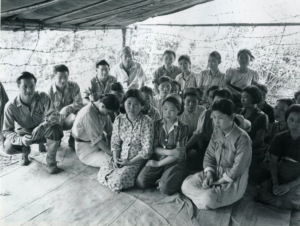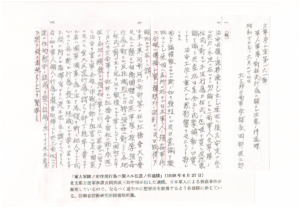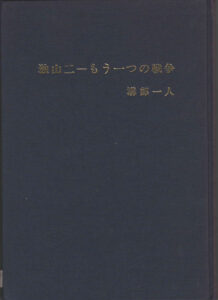The major point in the issue of Japanese military “comfort women” is whether there was coercion in comfort stations. Regardless of the manner in which the women were transported, even, for example, if they were brought in on luxury passenger liners, or in fancy cars on land, even if they came of their own free will, if they were coerced to provide sex to military and civilian personnel in comfort stations, which were military facilities, the military cannot escape responsibility.
On this point, the Statement by the Chief Cabinet Secretary Yohei Kono in 1993 acknowledges clearly that “they lived in misery at comfort stations under a coercive atmosphere.” This is an accurate statement. There are many testimonies from victimized women. And these testimonies coincide with the fact that many military and civilian personnel who actually used the comfort stations were repelled by the appalling conditions they found there.
Moreover, if the “comfort women” system was Sexual Slavery, then the women forced to provide sex to military and civilian personnel under such a system can’t be regarded as having done so of their own free will.
The following table shows a comparison between the “comfort women” system and the licensed prostitution system that existed in Japan. Both the licensed prostitution system and the “comfort women” system were Sexual Slavery, but there are a few differences in their forms.
| freedom to choose and change their residences | freedom to go out | freedom to quit | freedom to refuse | |
| licensed prostitution system | None | Not guaranteed. The Ministry of Home Affairs encouraged brothel owners to grant this freedom from 1933. | Despite legal provisions, in practice extremely difficult | In theory women became prostitutes of their own free will, but in practice it was difficult for them to refuse. |
| “comfort women” system | None | Not guaranteed. | Not guaranteed. | It was almost impossible to refuse. |
Under neither the licensed prostitution system nor the “comfort women” system were women given the freedom to choose orchange their residences. The requirement to live in residences in a controlled area is common to both systems. “Comfort women” had to live in designated tiny rooms.
Under the licensed prostitution system, the women were called “caged birds” and weren’t given the freedom to go out. However, in 1933 the Ministry of Home Affairs began to recommend that the permit system be abolished, and that prostitutes be guaranteed the freedom to go out, on the grounds that freedom to go out wasn’t guaranteed under the permit system. Foreign countries criticized the system of licensed prostitution, saying that it was actually Sexual Slavery, and one reason for this was that the women could not go out freely because of the permit system. The Ministry’s recommendations were made with the aim of avoiding this criticism.
In contrast, under the “comfort women” system, the Japanese military never guaranteed the freedom to go out in the first place. Regulations for military comfort stations include provisions that specifically prohibit women from leaving their assigned residences. For example, the “Internal Regulations for Stationing at Changzhou” set out by the 2nd Battalion of the Independent Heavy Artillery stationed at Changzhou, China in 1938 states that “Proprietors are prohibited from going out, except to specifically permitted places.”(“Proprietors” means “comfort women.”) This clearly indicates that the women were not free to leave their rooms.
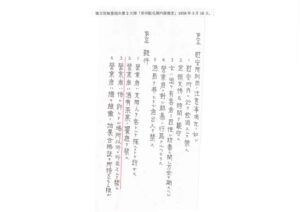
An abbreviation of “Dokuritsu-Sanhouhei-Dainirentai” (the 2nd Regiment of the Independent Mountain Artillery).
Regulations of the Iloilo Local Office, Visayas Branch of the Government Staff Office of the Philippine Military (Iloilo city, Panay Island) (1942) also “strictly regulates comfort women’s going out”, “Comfort women are strictly prohibited, without the permission of the Manager of the Iloilo Local Office, from going out.” Under the permit system, freedom to go out wasn’t guaranteed.
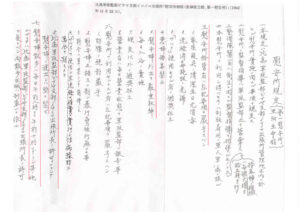
Iloilo Local Office, Visayas Branch of Government Staff Office of the Philippine Military, “Regulations for comfort stations (Asia Hall, the 1st comfort station)”(November 22nd, 1942).
Under the licensed prostitution system, the Ministry of Home Affairs laid down provisions concerning the freedom to quit in order to give the appearance that this system was not Sexual Slavery. “Freedom to retire” means that women forced to become prostitutes in red-light districts were guaranteed the right to leave the brothel behind immediately whenever they chose to do so.
However, these provisions were seldom put into practice. To begin with, most women brought to red-light districts didn’t know that they had the freedom to quit any time. And even if they did know, the brothel owners prevented them from notifying the police. Even if a woman had the good fortune to make her way to the police , the operator would always file a lawsuit demanding repayment of her debt. When her case came to court, the judge would almost always rule that the debt must be repaid, even though contracts to repay debts incurred by prostitution are null and void because they violate public order and morality. In such cases, regardless of provisions guaranteeing the freedom to quit, women in red-light districts who were unable to repay their debts continued to be arrested.
Thus, it should be noted that the licensed prostitution system is, in practice, Sexual Slavery. In contrast, under the “comfort women” system, there were no provisions concerning the freedom to quit in the first place. This freedom was ignored from the beginning.
Were they guaranteed the freedom to refuse customers? Under the licensed prostitution system, in theory the women became prostitutes of their own free will, but because they had to repay their debt, it would be difficult for them to refuse. Under the “comfort women” system, it was virtually impossible to refuse. If they refused, they were beaten by the operators or by military personnel.
In this way, both the licensed prostitution system and the “comfort women” system were forms of Sexual Slavery. The difference was that the licensed prostitution system was Sexual Slavery in practice, even though under civil law it appeared not to be. . The “comfort women” system, on the other hand, was literally Sexual Slavery under military law; it was unconcealed Sexual Slavery. It must be said that under this system, women providing sex to military personnel were forced to do so.


